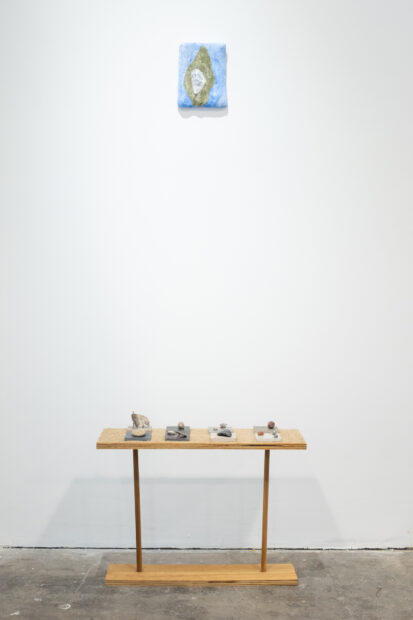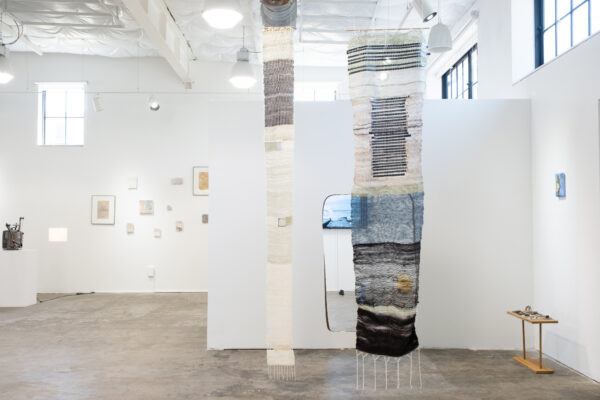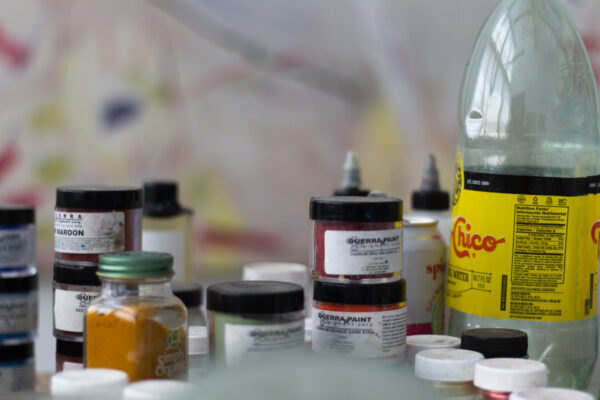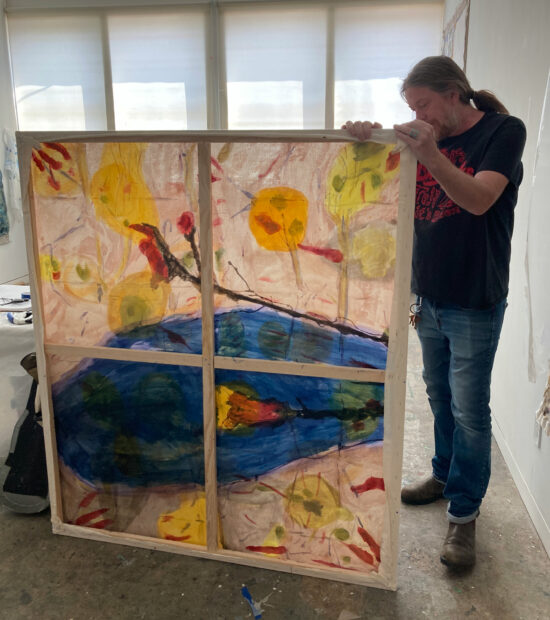“There were a couple of really good birds yesterday,” resident artist Samira Yamin told me in the Galveston Artist Residency (GAR) courtyard one sunny afternoon. She was leaving the studios when I happened upon her, squinting towards the sky with one hand cupped over her brow. I was walking to my apartment, hurriedly eating a scoop of lemon custard ice cream from LaKing’s Confectionery. Earlier that afternoon, Galveston Arts Center Curator Dennis Nance had advised me that it was the only place anywhere he knew to find the flavor. For Yamin, birding (the active version of the sedentary birdwatching) is a leisure activity that helps cleanse her palette of rigorous work in the studio over her past ten-month residency. For me, buying ice cream on the Strand is research. Time on the Gulf Coast has revealed that art and study are not such tidy, disparate endeavors.
Last October, I visited GAR to see what the three resident artists had begun producing. Take note: the beginning of a residency is not the best time to interrogate an artist. Though I was able to experience the city and many of its local artists, I left the region with the acknowledgement that I would have to return many months later to see output from the residents. If I wanted to see the work (and how the artists had been impacted by their lazy, beachy surroundings), I would have to wait for it to be made.
During this visit, all my prior revelations about the city were there, though dulled slightly; I wanted to know if the artists felt the way I did, that Galveston was a place of esotericism and exceptionalism. Did they agree? What drew their focus during their stint on the island?
Lili Chin

Lili Chin, “Limestone altar,” fresco, champagne silver, river sand, rocks from Scotland, limestone building tiles, oyster shell, pigment, foam, 65.5 x 24 x 15.5 inches. Photo courtesy of the artist
I asked Lili Chin what day it was during a studio visit. “I honestly have been a little out of touch with the time,” she responded. Being on “Island Time” is one of Galveston’s cheeky aphorisms — it is meant to express an air of lightness, that there are no deadlines here. However, these artists were working diligently to prepare for their residency exhibition, which opened on June 3.
“The site-ness of Galveston has definitely consumed a lot of my experience here.” Chin shot about five feet of 16-millimeter film every day on the shores of Galveston during the season of Lent. The water shown on screen is dark, and silvery where the sun hits it. It looks much more serious and heavy than it does when viewed in person while strolling across the seawall. Chin has made many observations of the coastal region during her stay here.

Lili Chin, “Machrie Moor dyptic,” Shetland wool, jute, handspun wool, developed 16mm film 58 x 48 x 9 inches; Scottish wool, cotton, developed 120mm film 62 x 44 x 23 inches; A diaristic record in memory of Machrie Moor, a collection of standing stones on the Isle of Arran. Photo courtesy of the artist
I turn to one fresco painting on the floor of the studio, which features a swirling, multicolored image that almost looks like a single-celled organism. It is a painting of Cesium-137, the radioactive isotope of Cesium, which is a byproduct of nuclear fission. It can be found all over the world; it marked the beginning of the atomic age, and is one of the most tangible forms of evidence of the anthropocene, or the geologic era in which humans have transformed the earth’s natural environment.
“I’ve been looking a lot at sediment cores and the different stratification layers,” Chin said. She was able to view some of these cores at the International Ocean Discovery Center (IODP) in College Station. Her engagement with Galveston has often been scientific. The geology of the gulf is often closely related to oil drilling, and the study of one topic will inevitably lead to the other. “It’s interesting because the geology also contributes to industry,” she said. In Chin’s work, there are always connections between materials.
William Warden
“I just don’t use tubes anymore. I’ve got ‘em, but when I start using them it doesn’t feel very satisfying,” William Warden told me in his painting studio. He has become accustomed to mixing his own paint, often of a stain-like quality, for his works on muslin. He will paint on the ground, in semi-controlled pours. He sometimes uses syringes to place color on the surface of a painting, and then moves it manually with palette knives.
Warden is a painter, in a distilled meaning of the word. The paint is just paint; there are no images or stories to be told in his compositions. Pigment is pressed into oil, and rabbit skin glue sizes the muslin. From there, it’s a matter of placing the paint and seeing where it is allowed to go, depending on if and how the sizing gets in its way. There are paintings which have vibrant color on the verso side of the work, but when flipped around have a much milder image. The process of handling the works to compare them, back to front, reveals that bright sunlight turns them into vibrant, glowing rectangles of color. They feel like dynamic, curious objects that reject the preciousness painting often evokes.
I had posed the question of whether the local climate gave him any concerns. Salt, humidity, and storms are real factors to consider in Galveston, as they impact many aspects of daily life on the island.
“I’m aware of archival issues, but I’ve also been taught that there’s a whole industry to deal with conservation,” he said. “I don’t know how long these paintings need to survive. It’s more of the painting [of] them that matters to me.”
Samira Yamin
Since my last visit, Samira Yamin had installed a darkroom in her studio. She was in the process of fitting the small alcove near the door to her space with blackout curtains, when she started to take a closer look at the material of the curtains. She pointed out that they are white fabric covered with a layer of black paint, and then a layer of white paint over that. “Being a person who works with light, this was really interesting to learn,” she told me.
Yamin’s work employs photographic processes to reveal the relationship between subjectivity and objectivity. In her Galveston studio, she has a small archive of family photos from Iran. Yamin recounted to me the different experiences she had between her paternal grandparents: her grandfather passed away when she was a teenager, and most of her memories of him are based on photographs. Her grandmother passed away when she was 30, and Yamin was able to spend enough time with her that other senses are tied to her memory. “I can hear her voice, in a way,” she says. After her passing, Yamin found a box of negatives in her grandmother’s home, one of which which featured an image of her grandparents standing next to each other. She used this as an example of how one image can conjure two different sets of memories:
“When I see photographs of my grandfather, because I don’t have much by way of memories of him, photographs are really valuable. With my grandmother, to be there, but not really be able to see her, this feels like a betrayal. I actually would just rather have my grandmother.”
In one case, the photo is a precious document of a relative that she does not have other tangible evidence of: her grandfather. In another case, the photo is a reminder of the passing of a family member that she misses dearly: her grandmother. One object offering both of these sensations shows the emotional underpinning to Yamin’s art.
Another body of work deals with scotoma, which are abnormalities appearing within an individual’s field of vision. Yamin describes the “scintillating scotoma,” which she inherited from her grandmother, as a “visual migraine aura.” “I’ve had them since I was a teenager,” she told me. They appear differently to different people, and are difficult to depict or draw, because of their evanescent, fleeting quality. However, when rifling through Yamin’s research materials, it becomes apparent that scotomas often begin small and then grow and migrate. “What I was trying to do with this project was to make a distortion where everything is still there, it’s just not necessarily in the right place.”
To do this, Yamin created a video projection featuring a photograph of a figure. The figure distorts very slowly over time, becoming more diffuse; if you were to view the video momentarily, it would appear still, but seen again a few minutes later, the changes become obvious. “This whole body of work is about the subjective aspects of representation, and finding those things where all the information is there but you see it differently,” she told me.

“The Thermal Conductivity of Tungsten,” from “The Visual Display of Quantitative Information” by Edward Tufte
Similarly to Chin, Yamin has an interest in scientific processes. She pulled out a book she acquired from Galveston’s Rosenberg Library during a book sale, Edward Tufte’s The Visual Display of Quantitative Information. While rifling through its pages, we discussed the artist’s license to choose when to organize information in rigidly logical order, or to design a scheme upon which data can be laid out in a visually stunning way. During our conversation, we landed upon one figure from Tufte’s book which shows the thermal conductivity of Tungsten on a scale of cold to hot. It seemed to be a perfect illustration of the concept of designing information not only for communication, but for elegance. Design and science can interact in a way that transcends either discipline. Yamin offered me one more thought about art making:
“I would rather not be restricted by the things that physicists are restricted by. For a reason, their job is different. My job is to do things that are not peer-reviewed.”
****
Lili Chin, William Warden, and Samira Yamin have all spent their first meaningful interaction with Texas and its people in Galveston. Year-long residencies are not common, and Galveston, since the fateful 1900 hurricane, has never regained its port prominence from nearby Houston. It is such a singular place to pursue one’s artistic practice, and the unique invitation for artists from elsewhere to take advantage of its charms is difficult to put into words.
My studio visits at the artist residency were transformative for myself, allowing me to witness the depth of creativity that is possible on the island. Galveston continues to provide fertile ground for self-reflection and the exploration of diverse perspectives. Watching these three artists grow into their residencies, I witnessed the multiplicity of the Texan milieu through the lenses of newcomers. GAR remains a treasure trove of inspiration, fostering connections and expanding horizons for all who venture into it.
Note: Travel accommodations for this piece were subsidized by the Galveston Artist Residency.
William Sarradet is the Assistant Editor for Glasstire.







